Sisters in STEM
Volume 2 Issue 1



Volume 2 Issue 1


At CSG, we empower girls to discover their distinct potential as learners and leaders. In the second issue of Sisters in STEM, we are proud to highlight the many ways our students learn and lead in science through curiosity, innovation, and discovery.
This issue captures the dynamic spirit of our science classrooms, from PYC through Form XII, showcasing how our students observe, explore, question, create, and grow. Each article reflects their passion and engagement, whether through research, experimentation, or creative inquiry.
What makes this publication truly special is the collaborative effort behind it. Our students have been integral to every stage of the journal’s production—contributing articles, offering thoughtful feedback to peers, and designing its layout. Their dedication and teamwork have brought this journal to life.
It has been an honor to guide this remarkable group as they share their scientific achievements with our community. We hope this issue inspires you to see the science woven into the world around us and to celebrate the endless possibilities of discovery.
Until next time, keep exploring!
Jeannie LaPlante Interim Director of the Center for Science Research & Engineering
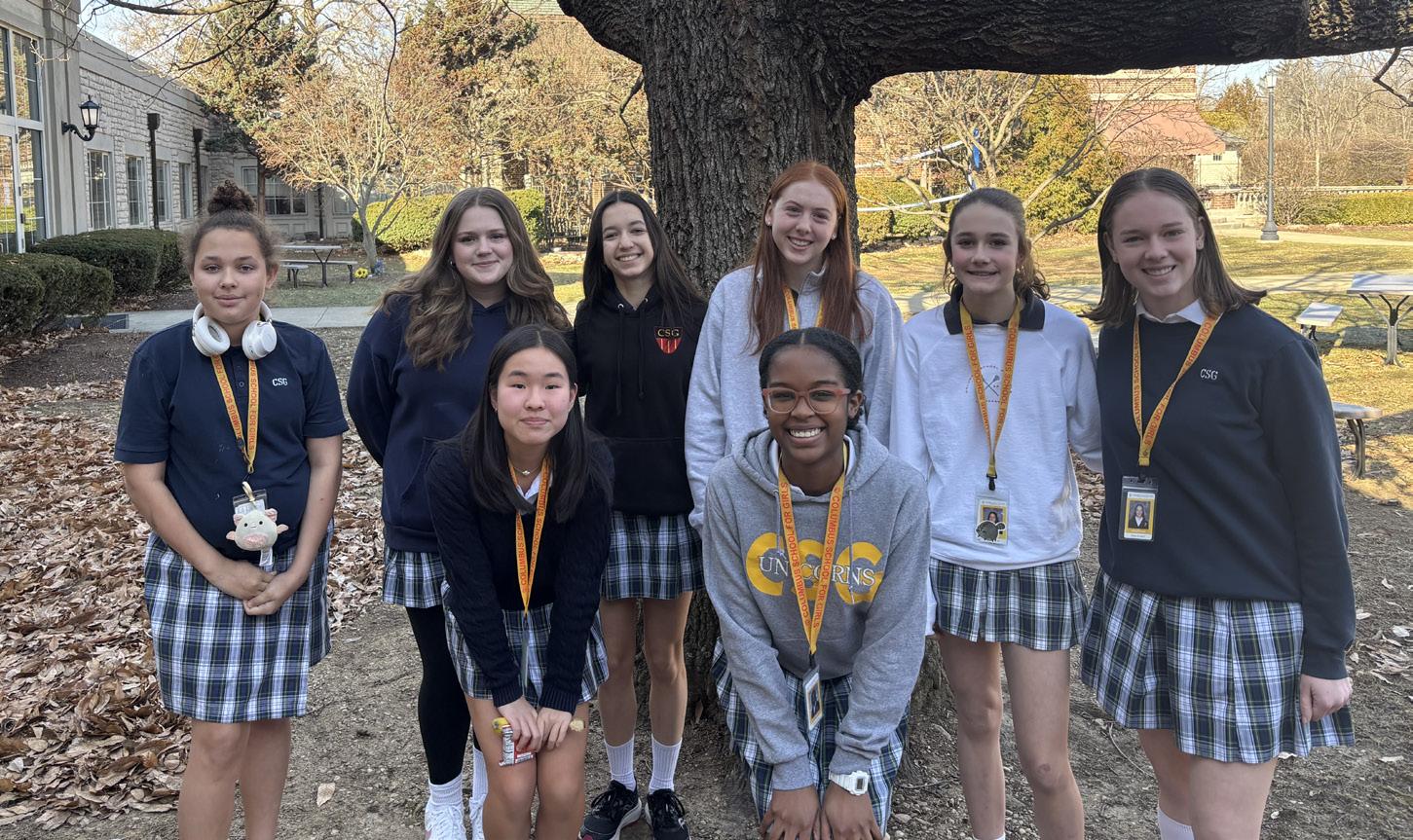

On the cover
Lower and Middle School students observe the solar eclipse at CSG on April 8, 2024.
Denley Aamodt ‘38, Italee Gunnell ‘38, Jrue James ‘38, Larkin Metz ‘38, Gigi Myers ‘38
Because children are curious about their natural world they often bring their discoveries to school to share with their classmates and teachers. In order to support an understanding of these objects and to encourage new discoveries, we ask the children to sketch the object using a drawing pen. Often other classmates share, “Iwanttosketch,too!”
The process of observational drawing begins as we encourage the children to sketch “what they see.”
Many times the children’s first attempt represents a learned sketch – what they think a butterfly looks like, including an overall general shape with a smiley face and hearts.
Using our senses to touch and examine the object, we question and discuss shape, color and unique details, which then supports the children to observe and thoughtfully sketch the object again as it appears.
Their sense of accomplishment is visible when they share their work with each others…the spark of a desire to know more begins.

Denley Aamodt



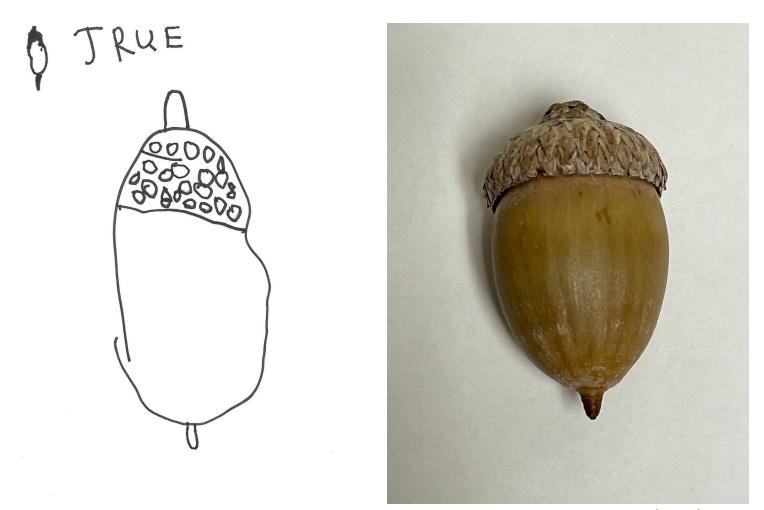
Fiona Wagner ‘34
After raising monarch caterpillars to the adult stage of butterflies, Form III students asked the question, “how does this butterfly species travel a long distance?” To help provide evidence for their hypothesis, they examined scales on monarch wings. They discovered different shapes, patterns and textures. By using the microscopes the students found evidence they needed to help answer their question.

1. Draw a Monarch wing Size: 6 cm Location: forewing
2. Magnified part of the wing.
3. Draw scales you saw.
I think the wing scales help the monarch by the color so predators don’t eat them. Also, if it’s cold the scales can protect the butterfly from the cold.
Caroline Adams ‘34
Form III studied life cycles of a variety of insects by raising them and observing interesting life stages. They determined insects had a complete metamorphosis or an incomplete metamorphosis during their observations then sketched the differences in their science notebooks. The fast growth of the milkweed bug and its incomplete life cycle stirred their curiosity to study them further and to witness their entire life cycle.

3 facts about milkweed bugs More facts We had three nymphs and they - 6 legs - herbivore turned into teens. - warning colors - eats milkweed seeds - true bug - will eat sunflower seeds
Alya Ateru ‘34
Form III students observed the growth and development of mealworms throughout their life cycles, recording their observations with sketches, written descriptions, and measurements.

Briar Slechter ‘34
While visiting Montana’s Glacier National Park, my family picked up the book Glacier National Park After Dark: Sunset to Sunrise in a Beloved Montana Wilderness by John Ashley.
What I learned from the book is that there are a lot of different skies in Montana. While visiting there was an 8:07 a.m. sunrise, a 1:15 p.m. meridian, and a 6:23 p.m. sunset. Sometimes moons will look like there are many moons. On page 34, a photo of “Ancient Circles” is my favorite as it is taken on Lake McDonald where we rented a boat. Sometimes the sky turns pinker and pinker then it turns blue. Sun pillars are beams of light that extend below and above from bright sources. People say purple moons are real, but they are not.
This was a great book; I think students my age would enjoy this book because there were pictures of the sunsets and the captions and narratives explained the pictures. I’m grateful we purchased this book while at Glacier National Park as it heightened my experience of seeing the same landscapes and skylines.


Have you ever wondered why colors spread out when Skittles get wet? It’s because of a process called diffusion! Diffusion happens when tiny particles spread out to fill up a space. Imagine you’re in a room filled with balloons. If you toss them into the air, they spread out all over! That’s what molecules do. They move from crowded areas to less crowded areas until everything is balanced. Scientists call this equilibrium. Cool, right? Skittles make diffusion super fun to watch!
Here’s the big question: Do Skittle colors spread out fastest in hot, warm, or cold water? We all guessed that hot water would be the fastest. Some of us thought warm water would come next, while others picked cold water. What do you think?
Materials
• A bag of Skittles (yum!)
• Three plates
• Hot, warm, and cold water
• Sugar
• A timer
• A phone or camera to snap pictures
1. Gather everything you need (Don’t eat the Skittles yet!)
2. Put Skittles in a circle around the edge of each plate.
3. Pour hot water on one plate, warm water on another, and cold water on the last plate.
4. Watch closely! How fast do the colors spread out? Use a timer to check.
5. Repeat steps 2 - 4, but this time, add a little sugar to the water on each plate. What happens now?
6. Take pictures of each plate to compare the cool patterns you see!




With Sugar - Colors blended together less when sugar was added
- More individual colors during diffusion
Without Sugar - Colors blended faster without sugar
- Colors were more blended together without sugar
- Colors blended together less when sugar was added
- More individual colors during diffusion
- Colors blended faster without sugar
- Colors were more blended together without sugar
- Colors blended together less when sugar was added
- Colors diffuse slower
- Colors blended faster without sugar
- Colors were more blended together without sugar
Conclusion
Hot water makes Skittle colors spread out the fastest, followed by warm water, and then cold water. Heat makes the molecules move faster!
When we added sugar, the colors didn’t mix as much. The sugar in the water made it harder for the colors to spread. This experiment was so colorful and fun! Try it at home and see what cool rainbows you can make.
Resources
“Visible Biology - Lesson 5: How Does Diffusion Work?” YouTube, uploaded by Visible Body, March 3, 2022, https://youtu.be/HKSJdzdTkdo?si=VPAD2VOZq4WquGAG
“Skittles Experiment” Toucan Box, https://www.toucanbox.com/activities/skittles-experiment
Eliza Horowitz ‘33
Before planting the seeds of the Wisconsin Fast Plant, Form IV students predicted what seeds need in order to germinate and grow. Form IV students also dissected an Alstroemeria flower in order to observe, sketch, and label the parts of a flowering plant.
I think inside a seed is an embryo, water, nutrients, and food.
5 things a seed needs to be able to grow are water, sun, food, healthy soil, and air.
A seed has 3 parts: the seed coat to protect the seed, an endosperm to give, keep, and eat the food, and an embryo is the baby plant.

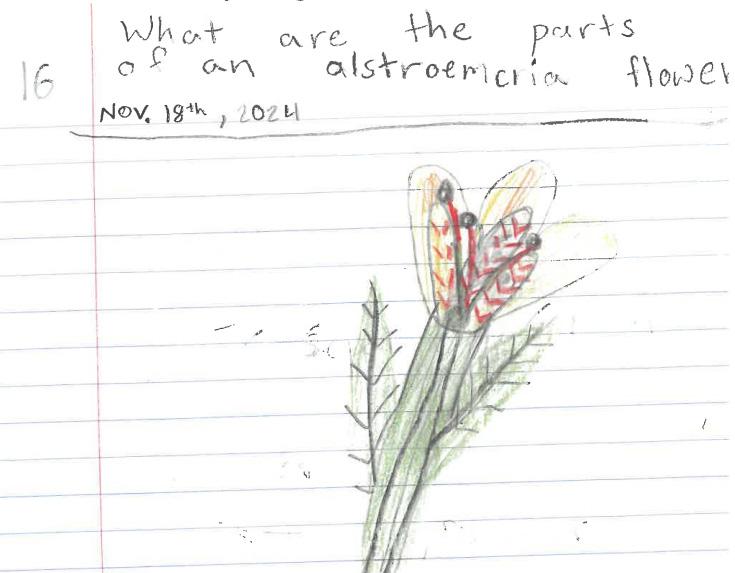

Phoebe Braselton ‘32
As a part of their Alstroemeria flower dissection, Form IV students observed and quantified various structures of this flowering plant.

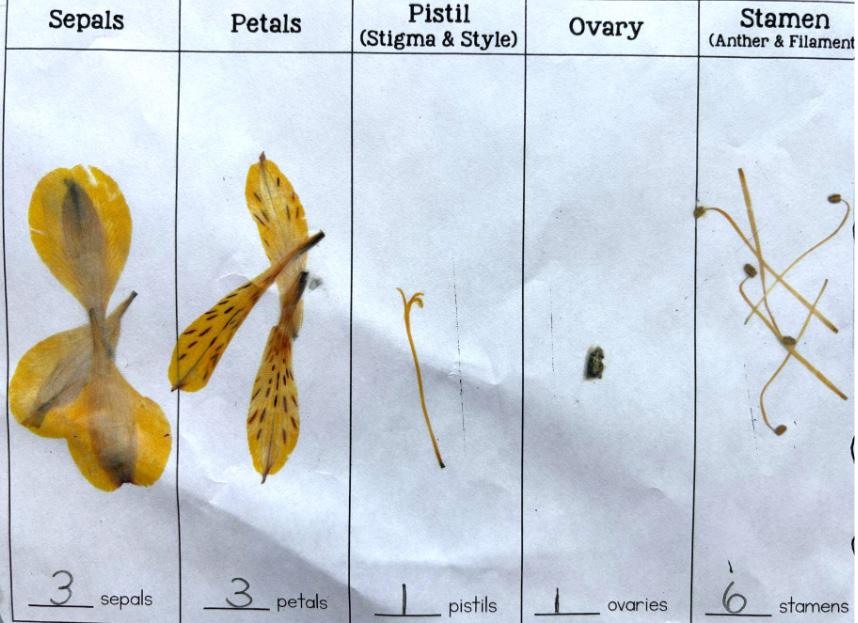
Annalise Schulte ‘33
In this experiment, my class asked the question: What traits are present in our group of Wisconsin fast plants?
Procedure
1. We planted the seeds in styrofoam containers.
2. We pollinated the flowers with bee sticks, watered them, and watched them grow for two months.
3. We predicted what was inside of the seeds and what they might look like (see next page).
4. We harvested the seeds when it was time.
5. In table groups, we identified the characteristics/traits of each plant.
6. We made a tally chart for each of the characteristics.
7. We made a bar graph from our tally chart data (see below).


I claim that non-hairy and non-purple stems have the most population. My evidence is that we grew 18 nonhairy and non-purple stem plants. I claim that the rosette-dwarf had the least. My evidence is that we grew 4.

I think inside a seed is food for bugs or animals, and a big white thing.
Prediction: A seed needs sunlight, soil, and water. A seed has 3 parts; the seed coat gives protection, the endosperm gives food to the plant, and the embryo is the baby plant.

I predict it to look like this. The seed pod is exactly 2 cm. I grew 3 seeds.
Ceci Olsen ‘32
Form IV students dissected, observed, and sketched the contents of an owl pellet in order to predict the types of animals ingested by these birds of prey. Students used field guides to identify the animal skulls found in their owl pellets and used this evidence to make a scientific claim about the types of animals that owls eat.
Owl Pellet Study Checklist
Length: 5 ½ cm
Width: 4 cm
Circumference: 9 cm
Weight of pellet: 7 grams
It feels like dry grass. I see a bone that might be a skull. I predict it has two bones in it. I think there is a vole inside. I see hay on the outside. There is fur covering it.
Why Study An Owl Pellet? To Learn…
- What it eats
- What types of bones you find (bone names)
- What type of owl it is
- To learn about it’s prey
- To learn about the prey’s structure
- To learn about the life cycle
- It’s interesting
- How much it’s eating
- Is the owl healthy?
- What prey is available
Barn Owl = Tyto alba
I claim that I have a shrew, a few vole skulls, and one mouse. My evidence is that I used the chart.


A book review by Maisie Streeter ‘32

The Gravity Tree by Anna Crowley and illustrated by Yas Imamura is the story about a little seed that grew to change the world. Imagine you are an apple tree seed, nestled down in the dirt, soaking up water. One day you start to shift and shake, split open, roots wisp into the ground. Growing by the day, you start stretching towards the sun, leaves burst and branches grow, until the little seed becomes a big long tree.
On one hot summer day, the tree was not alone. One of history’s greatest thinkers, Isaac Newton, spent his childhood under this tree, with his mind full of questions and the tree full of apples. THWACK! An apple fell from the tree smacking Isaac’s head. The Thwack set off an explosion of questions in his mind! But how come the apple does not bounce back up? Why did it not go up towards the sky? Why did it not skitter sideways?
This got him thinking of a bigger question: could that falling piece of fruit explain why the moon doesn’t float away from the earth or smash right into it? Isaac thought and thought, but then he came up with the answer: Gravity! Universal Gravity. He discovered that the invisible force that pulled the apple towards the center of the earth also kept the moon from drifting off into space. This discovery is one of the most important, and genius, scientific discoveries of all time. Isaac’s fate was set in motion, and the tree earned a new name: The gravity tree.
On one stormy day around 1820, wind whipped into a ferocious howl, sending the tree crashing down. Crowds carried away small pieces of the tree, an entire branch was used to make a chair! The tree itself was gone, Dead! But inside the tree, a part was still alive! With water, sunlight, and time, new roots formed, journeying deep into the dirt. On top of the trunk, a sprout uprooted, the branches continued growing and thickening, allowing the tree to grow bigger and bigger still. The tree regrew!
The gravity tree drew crowds, and one afternoon, a strange shadow of a man loomed over the tree. The man had wild, crazy hair poking out, under his hat - it was none other than Albert Einstein! World-famous Albert was on his way to give a lecture nearby about his own big and important ideas that were built on Isaac Newton’s discoveries 300 years earlier.
Albert had to see the tree that sparked his ideas, and he was not the only one who wanted to see the tree. Astronauts, astrophysicists, and thousands of scientists also come to the tree to spark their own ideas. On a cold winter day in 1987, the tree once again had another extraordinary thinker, at its trunk. World famous Stephen Hawking cast his eyes on the gravity tree, thinking of his own path in motion. Stephen was studying black holes, gravity, and the origins of everything, and none of his big ideas about the cosmos would have been possible without the tree.
The apple that once dropped on Newton’s head inspired him to uncover all of his great mysteries, which sparked more discoveries, and just like that, one small apple seed could end up changing the world. The tree’s work is not done, no matter the decade or century, the tree continues to inspire people to be able to do great things. On one spring day in 2010, it wasn’t who the tree was meeting, but where the tree was headed. At the international space station, an astronaut released a sliver of the tree out of his grip, and instead of falling down to earth, it floated. Nearly 350 years later, Isaac was right! The gravity tree has spread to different parts of the world and embarked on many life-changing journeys, but it all started with a single apple seed.
This book showed that even if you are little you can do a lot, it showed how our world has changed for the better, it also showed that even if something great is destroyed a newer version could come back better than before. The Gravity Tree was funny and taught amazing things in a way for all ages to enjoy. I recommend this book for 2nd grade and up.
References
Redding, A. (2021), The Gravity Tree (The True Story of a Tree That Inspired the World)
Lolo Pennington ‘32
During Form V’s Week in theWoods experience at Cynthia’s Woods, students hiked around the property to discover three different ecosystems: the forest, the creek, and the meadow. At each, students engaged in a See/Think/Wonder thinking routine and recorded their ideas.

I think… there are lots of different tree types.
I wonder…how many tree and plant types are there?
Creek
I think… that the fallen trees in the water make perfect hiding spots for creatures like frogs, toads, and salamanders.
I wonder … how deep is the creek? Are there fish in it?
I think… that lots of birds and pollinators would like this because there are lots of flowers and plants.
I wonder… why do so many flowers grow here?
Phoebe Braselton ‘32
Form IV students collected sand on their summer vacations across the country and around the world. Upon returning to school in the fall, they observed samples from different locations using a stereomicroscope and documented their observations.
Sand Observations
Sand #1: Vik Beach, Iceland
Feels rocky
Sand #2: Blue Mountain Beach, FL
Sparkly Pearl-like
Sand #3: Great Sand Dune, CO
Sparkly Rock-like
Sand Reflection
The microscope helped me look at the small grains of sand.
The microscope made them look like rocks. Some look chunky, some look smooth. Some were brown, white, and tan.
What I learned about sand
Sand is made of quartz, dried lava, coral, and lots of other minerals. There are many other sand colors such as pink, red, purple, black, green, tan, and even orange! How was sand made? It’s called weathering. Rocks are broken up by the ocean and brought to the surface.

Annabel Lipscomb-Jackson
First, what is artificial intelligence? Well, AI, which stands for artificial intelligence, is a misleading title, since there’s no real intelligence, as we define it, behind the algorithms of AI tools. AI tools don’t really understand the data they process, and they lack decision-making, self awareness, and a basic understanding of our world. All these programs do is put together their answers or images from data fed to them. The process in which said data is fed to them is called “training.” A somewhat less misleading term is machine learning, although these algorithms don’t learn in the way humans or other life forms do. However, these machines are surprisingly effective in multiple areas, such as text and image generation. Some AI text and images are quite hard to recognize as AI-generated.
Now, let’s take a look at the history of AI. The history of AI started with Alan Turing in the 1930’s and 1940’s with the Turing Test, a famous test used to evaluate machine intelligence. His ideas laid the groundwork for other important figures such as John McCarthy, as well as early programs such as Logic Theorist and Perceptron. John McCarthy, the “Father of Artificial Intelligence,” coined the term artificial intelligence. AI offers benefits such as increased safety and efficiency, but also negatives such as job displacement and algorithmic biases.
Next, let’s discuss the pros and cons of AI. The pros of AI include making the quality of life better, making work simpler for students and professionals, helping marginalized groups by offering accessibility for the disabled, and improving workplace safety. The cons include replacing human jobs leaving many unemployed, spurring disinformation and opinions staged as facts, hurting racial minorities by replicating and repeating human racism, and posing privacy risks.
Now, let’s talk about algorithmic bias. Algorithmic bias is like human bias in the sense that it results in unfairness, as the AI learns from the internet, which contains all sorts of biases. However, algorithmic bias can spread much faster than human bias and expand on a much larger scale. The reason for this bias is due to a limited training set. Using a more selective training set leaves out many members of our community. When it comes to address-
ing this type of bias, you can make a huge difference. If you want to learn more, there is a fantastic TED Talk called "How I'm fighting bias in algorithms" by Joy Buolamwini that talks about algorithmic biases and the coded gaze. Masha Hamilton also wrote about the coded gaze movement in her article entitled, "The Coded Gaze: Unpacking Biases in Algorithms That Perpetuate Inequity." In this article, I learned a lot about how AI biases affect facial recognition, including how a lot of facial recognition AI struggles to recognize those with darker skin, due to learning from a non-diverse training set of faces.
Next, let’s talk about how AI art generators ‘steal’ our art. The language and image generators require a source to pull from, as they can’t generate art naturally like human artists are able to. So where do the references come from? Well, they come from human artists. These AI programs pull from human creation, sometimes outright copying it, to make media for its users. It is taken from books, the media, the internet, everywhere. In particular, the image generators pull from billions of posted works by artists on the internet. If it’s on the internet, you can assume it’s been taken.
Now that we’ve covered the problem, let’s discuss the solution. If you’re an artist who posts artwork, there are multiple ways to prevent this. One is adding a watermark to your project. A watermark is like a password protecting your work. Another way is opting out. Some AI bots are recognizing rights and allowing artists to opt out. However, there are a few caveats. As AI opt-out mechanics are evolving, it only works for future AI bots, and is often a very tedious process. Another method is image cloaking. Image cloaking is a nearly invisible protective barrier, not seen to humans, but will make your art practically invisible to AI bots. You can also take legal action. If you aren’t an artist, you can still help by spreading the word about the dangers of artificial intelligence!
Bausenhardt, Julia. "How AI is stealing your art." Juliabausenhardt, Julia Bausenhardt, 3 Feb. 2023, juliabausenhardt.com/how-ai-is-stealingyour-art/. Accessed 29 Nov. 2024.
Copeland, B.J.. "History of artificial intelligence (AI)." Encyclopedia Britannica, 13 Sep. 2024, https://www.britannica.com/science/history-of-artificial-intelligence. Accessed 29 November 2024.
Doermann, David S. "Artificial Intelligence." World Book Student, World Book, 2024, www.worldbookonline.com/student-new/#/article/home/ ar032470. Accessed 30 Nov. 2024.
Hamilton, Masha. “The Coded Gaze: Unpacking Biases in Algorithms That Perpetuate Inequity.” The Rockefeller Foundation, 16 Dec. 2020, https:// www.rockefellerfoundation.org/grantee-impact-stories/unpacking-biases-in-algorithms-that-perpetuate-inequity/
"How I'm fighting bias in algorithms | Joy Buolamwini." Youtube, uploaded by TED, 29 Mar. 2017, www.youtube.com/watch?v=UG_X_7g63rY. Accessed 3 Dec. 2024.
"How to protect your art from AI in 2024." Gelato, 6 May 2024, www.gelato.com/blog/how-to-protect-your-art-from-ai. Accessed 29 Nov. 2024.
ProCon, The Editors of. "Artificial Intelligence (AI)." Encyclopedia Britannica, 25 Nov. 2024, https://www.britannica.com/procon/artificial-intelligence-AI-debate. Accessed 29 November 2024.
"What is the history of AI?" Britannica AI, Britannica, www.britannica.com/technology/artificial-intelligence.
Wikipedia contributors. "Artificial intelligence." Wikipedia, The Free Encyclopedia. Wikipedia, The Free Encyclopedia, 25 Nov. 2024. Web. 29 Nov. 2024.
Jasmine Davis ‘31
In Vitro Fertilization (IVF) was researched by three principal investigators Dr. Patrick Steptoe, Dr. Bob Edwards, and Jean Purdy. These three scientists did their research in a hospital in England called Kershaw. IVF is when human fertilization takes place outside of the body. It took 10 years for IVF to happen and now over 10 million babies have been born due to IVF. Dr. Patrick Steptoe, Dr. Bob Edwards, and Jean Purdy first did their research on mice then moved to humans. Women older than 35 were not able to be a part of the research study. Those women couldn’t participate because older eggs have a higher chance of complications.
IVF is important because it helps women have babies who couldn’t naturally conceive. One of the more common reasons women can’t have babies is because of endometriosis. Endometriosis is when the tissue inside the uterus forms outside the uterus. When a woman has her cycle, the blood is trapped in the body and it is painful.
Dr. Bob Edwards was born September 27,1925 and died April 10, 2013. Edwards won the Nobel Prize in Medicine in 2010 for In Vitro Fertilization (IVF). Edwards was a physiologist and had the idea to fertilize the baby outside of the body. Edwards knew that open surgery was not the way to do it, and so, he sought out Steptoe.

Dr. Patrick Steptoe was important to IVF because he was one of the doctors who invented this process. He was born on June 9, 1913 and died on March 21, 1988. Steptoe did laparoscopic surgery, and he was also a gynecologist. Laparoscopic surgery was invented in the early 1930’s and requires a tool called a laparoscope. The old way of seeing into the pelvis or the abdomen was called open surgery, which required a large incision so the doctor could reach into the body cavity. The risk from open surgery was that it took a long time to heal and there could be a potential damage to the bladder. Laparoscopic surgery was where the doctor made tiny incisions into the body and the doctor could see into the pelvis or abdomen. The benefits of laparoscopic surgery was faster recovery and less scarring to the body.
Jean Purdy was born April 25, 1945 she died March 16, 1985 from cancer. Purdy was a nurse and an embryologist. She lived a short life but had a major contribution to the world. Jean Purdy had severe endometriosis such that she was unable to benefit from IVF. Purdy was the one who suggested they sync the process with the natural cycle of the women’s body, after they struggled to have success with the first few pregnancies during their research.


The first baby born through IVF was Louise Joy Brown born July 25, 1978. Dr. Patrick Steptoe chose her middle name, Joy, to honor the success they had on delivering the first IVF baby. In addition, she wrote a book titled “My World as the First Test Tube Baby.” The book talks about her birth and the big impact it made on the world. Today, Louise Brown continues to be an ambassador for IVF and fertility treatments.

At the time that IVF was introduced, people were afraid of this new process. They were afraid of the possibility of abnormalities when fertilization takes place outside of the body. Some people held religious beliefs that went against this new technology. In a passage from the Bible, Genesis chapter 25 verse 21 Isaac’s wife was barren and he prayed to God and He allowed her to conceive. Some people believed that only God can help women have babies, not science. People were concerned that this new procedure would be harmful to babies.
The doctors were also challenged to develop this process because they initially used a material called liquid paraffin that turned out to be toxic to the fetus. Like good scientists, they improved their methods to make this process safer for everyone, which ultimately led to baby Louise being born.
When I was looking at topics to research, this topic stood out to me because when I grow up I want to be an Obstetrician gynecologist. When I dove more into this topic I watched a movie called, Joy: The Birth of IVF. In this movie it was really interesting to see the nurses administering the medication to the mom. In addition, it was intriguing to see how many times the scientists
failed and learned from their mistakes. It took ten years to develop IVF, and now over ten million babies have been born as a result of this procedure. Also, it was inspiring to see how the doctors gave women who couldn’t have children hope of expanding their family. The movie impacted my vision in how I can expand medicine in a similar way.
“Home of Patrick Steptoe, ‘Father of IVF’, honoured with Blue Plaque.” Bourn Hall, www.bournhall.co.uk/news-events/patrick-steptoe-father-of-ivf/. Accessed 12 Feb. 2025.
“How Old Is Too Old for In Vitro Fertilization?” Reproductive Gynecology and Infertility, www.rgiohio.com/blog/how-old-is-too-old-ivf. Accessed 14 Feb. 2025.
“In-Vitro Fertilization | 2 min read The History of IVF: Origin and Developments of the 20th Century.” Pacific Fertility Center Los Angeles, www.pfcla.com/blog/history-of-ivf. Accessed 30 Jan. 2025.
“Jean Purdy, IVF pioneer and co-founder of Bourn Hall.” Bourn Hall, www.bournhall.co.uk/fertilityblog/jean-purdy-ivf-pioneer/. Accessed 12 Feb. 2025.
“Robert Edwards.” Britannica, www.britannica.com/biography/Robert-Edwards. Accessed 12 Feb. 2025.
“Where Is the First ‘Test-Tube Baby’ Now? All About Louise Joy Brown, the First Child Ever Born via IVF.” People, people.com/where-is-louise-joy-brown-the-first-ivf-baby-now-8748006.
Emmeline Chapman ‘31
In Mrs. Biswas’ sixth grade science class during the fall of 2024, we studied different types of cells. At the beginning of the investigation, we knew that only plants had cell walls, chloroplasts, and a large central vacuole. Animal cells have a cell membrane not a cell wall. Also, animal cells don’t have a chloroplast or a large central vacuole like the plant cell. The cell membrane acts like a guard, directing what goes in and out of the cell. On the other hand, the cell wall is like a brick wall, it protects the cell from the outside. My goal for this investigation was to find out what types of cell structures were on the unknown slides. Our guiding question was: what types of cells are on the unknown slides?
My claim is that slides 1 and 4 are plant cells and slides 2 and 3 are animal cells. My justification that slides 2 and 3 are animal cells is because I couldn’t find or see a cell wall, chloroplasts, or a large central vacuole. In addition, slides 2 and 3 looked more closely like the known animal cell slides. Slides 1 and 4 are plant cells because I saw a cell wall and they looked like the known plant cell slides. My data is shown in Table 1 (to the right).
First, I discussed with my lab partner how we should organize and collect the data. Then, I made a data table to track what we observed on the unknown slides. On the data table, I was looking for a cell wall, chloroplasts, and a large central vacuole. To determine if there is a cell wall, you have to find the darker rigid outer layer. I formatted the data table with those previously stated three items and looked for them under a microscope. Then, I compared my observations from the known slides and unknown slides to figure out which slides were animal or plant.
I determined slide 1 and 4 were plant cells because I found a cell wall, though I didn’t see chloroplasts or a large central vacuole. I confirmed that Slide 1 and 4 were plant cells because I compared them to the known plant slides. I did the same for slides 2 and 3 but they didn’t look like they were a plant cell because I did not see a cell wall. Next, I looked at two known animal cell slides. Slides 2 and 3 looked most similar to the known animal cell slides. I analyzed the data I collected by finding which slides had the most in common with plant cells versus animal cells.
Unknown Slide 1
Unknown Slide 2
Unknown Slide 3
Unknown Slide 4
Human lung







Lily leaf

Didn’t see Didn’t see




Didn’t see Didn’t see
























Table 1. In the plant cells, I could only really see a cell wall, but I knew there also had to be a chloroplast and a large central vacuole. This analysis indicates that slide 1 and 4 are plants and slides 2 and 3 are animals.
Eva Smith ‘31
We have been studying cell structures in science class. At the beginning of the investigation, we knew what structures are in plant cells and the structures of animal cells. In this investigation, I made observations about several unknown slides to look for characteristics of an animal cell or a plant cell. I looked for cell structures like a chloroplast, a cell wall, a cell membrane, and a central vacuole to find out what type of cells were on the unknown slides.
My goal for this investigation was to identify some unknown slides and figure out if they were animal cells or plant cells. Our guiding question for this investigation was: what type of cells are on the unknown slides?
My group’s claim was that unknown slides 1 and 4 were plant cells and unknown slides 2 and 3 were animal cells. We made this decision based on which cell structures were on the unknown slides. We looked for a chloroplast, cell wall, and a central vacuole to decide if our slides were plant cell or animal cell on the unknown slides. If the cell had chloroplast, a cell wall, and central vacuole, then it was a plant cell. If it did not have chloroplast, cell wall, or a central vacuole, then it was an animal cell. We used this evidence to decide if the cells on the unknown slides were plant or animal cells.
The table to the right shows our data and our observations, which we used to determine which was a plant cell or an animal cell.
1. My group placed the first known slide under the microscope and observed the cells, looking for the presence of chloroplast, central vacuole, cell membrane and cell wall.
2. On our data table, we recorded whether we observed each cell structure and took notes on the general appearance of the cells.
3. We repeated steps 1 and 2 for the three remaining known slides.
4. My group placed the first unknown slide under the microscope, and observed the cells, looking for the presence of chloroplast, central vacuole, cell membrane and cell wall.
5. On our data table, we recorded whether we observed each cell structure and took notes on the general appearance of the cells.
6. We repeated steps 4 and 5 for the three remaining unknown slides.
7. We then analyzed the data collected by comparing and contrasting the unknown slides to the known slides.
The conclusion is that there were two unknown plant slides and two unknown slides were animal slides. We know this based on whether the cells had a central vacuole, cell wall, chloroplast, and a cell membrane. We made these inferences by using what we observed on the known slides.
Specimens
Slide 1 (Animal)
Slide 2 (Plant)








Shapes & structures
Observation
Circles I saw lots of tiny pink circles with a few tiny black dots
Dots / Mural I saw pink mural with really tiny black dots
Slide 3 (Animal) N/A It looks like snake skin
Slide 4 (Plant)
Unknown slide 1
Unknown slide 2
Unknown slide 3
Unknown slide 4
























Triangles It looks like snake skin in triangles
Rectangles I saw blue rectangles
Circle/ Blobs I saw purple circle blobs
Dots I saw purple dots with empty white space
Hexagons I saw pink hexagons
Sabrina Anderson ‘29
The Chinese Mitten Crab is an invasive species native to East Asia, recognized by its distinctive furry claws that resemble mittens. Its smooth, rounded top shell typically measures around 3 inches in width, while its long legs—often twice the length of its carapace—add to its unique appearance. This burrowing crab poses a significant threat to coastal ecosystems, as its rapid spread disrupts habitats and damages local biodiversity. Its presence along coastlines creates widespread environmental challenges, making it a major concern for conservation efforts.
The Chinese Mitten Crab is an invasive species that spreads rapidly once introduced to new areas. Initially brought in as bait for fishing and feed for livestock, it has since become a significant environmental concern. One of its major impacts is its burrowing behavior, which damages dikes, levees, and stream banks. In California, the crabs have disrupted water operations by clogging fish salvage structures at diversion facilities. They also pose a threat to anglers by stealing bait, damaging fishing nets, and competing with native species for resources.
The Chinese Mitten Crab is native to East Asia, from Northern China to the Korean peninsula. Although native to Asia, the Chinese Mitten Crab can be found on the coasts of Northern and Eastern Europe and the western coast of the United States. Their highest concentration is found in saltwater while the females are laying eggs. They could be found in lakes, rivers, creeks, and large water sources, such as Lake Erie and throughout the other Great Lakes. In 1912, this crab spread to 19 European countries, the San Francisco Bay, and the Chesapeake Bay. They are also catadromous, meaning they migrate from freshwater to brackish-marine waters.
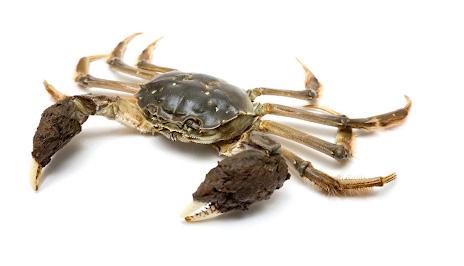
The Chinese Mitten Crab is thought to have been introduced to the U.S. and European coasts primarily through ship ballast water, and possibly through intentional releases to establish fisheries. Additionally, they may have traveled via aquarium trades and live seafood markets. In some cases, live crabs imported for food may have escaped, further contributing to their unintentional introduction in certain areas. Once established, the Chinese Mitten Crab can spread quickly through the dispersal of larvae in the water column.
The Chinese Mitten Crab impacts native species through predation and competition, particularly on salmonid, sturgeon eggs, and juveniles. Additionally, efforts to control the crab by introducing other invasive species to prey on them have unintentionally led to further harm, as these new species also target native wildlife.

The Chinese Mitten Crab’s burrowing activities can cause damage to dikes, levees, and stream banks. These burrowing activities can cause erosion, weakening, or collapsing flood control in water supply systems. This interferes with fisheries, as the crabs steal bait, damage fishing gear, and the fisherman’s catch. They also have caused industry disruptions by blocking the cooling systems of power plants. With all of this, the government and wildlife centers have spent a vast amount of time and money removing them, even though they continue to breed and spread throughout the coasts. In the San Francisco Bay, eliminating the crabs from the nets has been time-consuming and costly to shrimp trawlers. For example, one trawler worker has reported catching over 200 crabs in a single tow multiple times.
The Chinese Mitten Crab poses a health risk to humans as it serves as an intermediate host for the Oriental lung fluke. Additionally, humans and other mammals can become infected by consuming raw or undercooked crabs. Furthermore, mitten crabs often inhabit contaminated areas, and the bioaccumulation of toxins in their bodies can be transferred to mammals. In this way, the crabs impact both the ecosystem indirectly and human health directly.
The government has implemented several measures to prevent the spread of Chinese Mitten Crabs. For example, in 1999, wildlife control committees began developing a Mitten Crab management plan. In California, it is now illegal to transport or import Chinese Mitten Crabs, and in the rest of the U.S., transporting them without a permit is prohibited. Additionally, ships are required to release ballast water in the open ocean before arriving in the U.S. Physical control methods, including traps, trawls, and barriers, are used to manage the crab population. Although chemical controls, such as inhibitors and disruptors, have been tested, they are not viable due to the species’ dispersal. These management strategies are most effective during the crabs’ migration season, when they are concentrated in predictable breeding areas and more vulnerable to removal. This timing helps control
their population and minimize their impact on local ecosystems.
In conclusion, the Chinese Mitten Crab poses a significant threat to ecosystems, native species, infrastructure, and public health. Despite control efforts and legal measures, its spread continues to outpace management strategies. Effective solutions will require stricter enforcement, advanced technologies, and greater public awareness to reduce its long-term impacts.
“California’s Invaders: Chinese Mitten Crab.” California Department of Fish and Wildlife. Last modified 2023. Accessed October 6, 2023. https://wildlife.ca.gov/Conservation/Invasives/Species/Mitten-Crab. “Chinese Mitten Crab.” Seattle Sea Grant. Accessed October 11, 2023.
https://seagrant.unh.edu/sites/default/files/media/2021-11/chinese-mitten-crab-management.pdf. “Chinese Mitten Crab Facts.” Sea Grant Washington. Last modified 2020. Accessed October 6, 2023.
https://wsg.washington.edu/community-outreach/outreach-detail-pages/mitten-crab/#:~:text=The%20mitten%20crab%20 may%20have,and%20 sturgeon%20eggs%20and%20 juveniles. D.E.C Editors + Authors. “Chinese Mitten Crab.” Department of Environmental Conservation. Last modified 2018. Accessed October 6, 2023.
https://www.dec.ny.gov/animals/35888.html#:~:text=Mitten%20 crabs%20are%20native%20to,brackish%2d Marine%20waters%20 to%20 spawn. Metzler., Jennifer L. “Chinese Mitten Crab.” Water Education. Accessed October 11, 2023.
https://www.watereducation.org/sites/main/files/file-attachments/ chinese_mitten_crab.pdf. PowerPoint Presentation. Last modified 2016. Accessed October 6, 2023.
https://www.biology.colostate.edu/wp-content/uploads/ sites/21/2020/04/mosalgrant_162280_14544105_chinese-mitten-crab-1.pdf. Solovyeva, A. and K. Bailey 2008. “Eriocheir sinensis” (On-line), Animal Diversity Web. Accessed October 06, 2023 at https://animaldiversity.org/accounts/Eriocheir_sinensis/
Mae Austin ‘28
On April 8, 2024, there was a total solar eclipse that passed through Ohio. My parents, brothers, grandparents, and I drove to a place called Mad River so we could view the total solar eclipse. This is because where I live we were just outside the path of totality. Around 2 p.m., the partial eclipse started. Otterbein University set up telescopes so people could view the sunspots on the sun. When looking at the sun, at first it looked the same as the typical sun. Then it looked like Pac Man, then a crescent, and finally the sun looked like a fingernail (because there was so little of it that was visible). At Mad River, the total eclipse started at 3:10 p.m. and lasted for three minutes. I was able to tell that the moon wasn’t a perfect circle, and I could see the sun flares and prominences from behind the moon during the total solar eclipse.
The total solar eclipse was impactful to me and many others because of how rare its occurrence is. A total solar eclipse happens when the moon passes between the sun and the earth, and the moon completely blocks the sun. In order for a total solar eclipse to happen, those three figures have to be completely lined up, which means that this is a very rare occurrence. A partial solar eclipse, which is more common, still has the moon between the sun and Earth, but only part of the sun is covered. This gives the sun a crescent shape. Overall, the total solar eclipse was a really incredible experience to be able to see!


2:

Figure 3: An experiment my grandpa did that was similar to what Otterbein did. He was able to use his binoculars and project the eclipse on his cooler.
Jiawen Yi ‘26
Nowadays, many people hug their plush toy without a hug back. Giving a hug is not equal to being hugged. Also, sometimes a simple hug can be a type of support and emotional connection. Why do people need a hug? What will a hug be like from a plush toy? How could the plush toy move and give a hug? The article aims to address these questions and propose a solution.
Hugs are one of the most important human reactions. There are many benefits of hugging from the mental and physical perspective. Hugging improves productions of oxytocin and serotonin, gives emotional support, and lowers blood pressure. It also increases immunity and promotes heart health.
Nowadays, there are many plush toys in people’s houses. There are all kinds of plush toys produced to improve human interaction. For example, weighted plush toys are filled with weighted materials, which offers a sensation of being hugged. In addition, interactive plush toys have more varieties. They have voice records, changeable clothes, and body movement. Evenmore, the oversized plush toys simulate the size of humans that provide a feeling of being surrounded.
Function Requirement
Temperature Simulate human skin temperature

The solution is broken down into different sections to approach from each aspect. The visual solution of the hug plush toy (seen in the figure above) was created using Adobe Illustrator. There are several helpful resources to gather details in problem solving. For instance, SnakeClamp introduces usage of Gooseneck Tobe, and TFP Technology GmbH details the function and advantages of Carbon Heat Mat.
Parts Position Decision
Carbon Heat Mat, Heating battery, Switch
Battery and Switch: back
Carbon Fiber: under surface

Shape Personalized
Size For people in different sizes
Movement Adjustable pressure
Message Speak pre-recorded message: “I love you”
Material Soft, Conduct heat
Customized shape N/A
Customized size N/A
Frame inside with Flexible Gooseneck, Hose Tube covered with silicone
Sound Module, Switch Circuit board, Speaker
Filled with Polyester Covered with Velboa
Washable Easy to take out electric parts Zipper
Environment Use environmentally friendly materials
Recycle materials
Rechargeable battery
Limbs, Center of body
On the back
Inside: Polyester Outside: Velboa
Back
N/A







Mia Dela Cruz ‘25
Chronic Inflammatory Demyelinating Polyradiculoneuropathy (CIDP) is a rare autoimmune nervous system disorder that targets and attacks the myelin sheaths. Myelin allows nerve cells to communicate and helps them function. There are an estimated 5-7 cases of CIDP per 100,000 people7. CIDP causes patients to experience symptoms including loss of feeling in arms and legs, tingling sensation, decreased ability to grip, and loss of reflexes1,2,3. While the exact cause of CIDP is unknown, autoimmune disorders such as CIDP involve the immune system attacking itself and destroying myelin, a protective layer of proteins and lipids wrapped around the nerves and spine. Myelin destruction causes the patient’s nerves to stop working and function slower. This disease is thought to be closely related to Guillain-Barre syndrome, which involves the immune system attacking the nerves, and medical experts believe that CIDP could potentially be the long-term form of the disease1. However, CIDP is not a fatal condition. Nearly all patients who contract CIDP have an equal survival rate2 to those who do not have CIDP. Several treatment options are currently available for CIDP, including various types of drug therapy, plasma exchange1,5, and stem cell therapy10,12,13. Currently, medical researchers are conducting several clinical trials to determine the most effective diagnosis and treatment methods for CIDP. Their clinical trials and experiments have determined that MRI and MRN imaging are reliable methods to detect CIDP and associated autoimmune diseases.
CIDP is a rare disease, with only an estimated 5-7 cases per 100,000 individuals7. Of those who contract CIDP, 90% of patients reported that their symptoms improved following treatment7. Although people of all ages can contract CIDP, the disease is most prevalent in middle-aged and elderly adults. Men are at higher risk of developing CIDP than women, approximately twice as much5. A group of medical researchers from the Netherlands conducted a study7 from 2008-2017 on the prevalence of CIDP through a population-based cohort study. In this study, the researchers assessed whether or not demographic factors corresponded with risk factors for developing CIDP. Additionally, they compared their study with one that had been previously conducted by a Dutch cohort study and found the overall prevalence of CIDP to be 7 cases per 100,000 individuals7. Subsequently, the researchers found that 20% of those who had CIDP also had Myotonic Dystrophy (DM), a muscular condition that causes weakness in the muscles, or a different autoimmune disorder, determining that having a preexisting autoimmune disorder increases the risk of developing CIDP later on in their lives. The researchers of this study found the median age of onset to be 58 years old, and 66% of those who had CIDP were men7. Moreover, a common trend of CIDP cases was that the disease tended to develop in middle-aged to elderly men as well as people who had a preexisting autoimmune disorder.
Numerous researchers are in the process of researching CIDP to determine the cause of the disease as well as the most effective treatment options for patients. Since CIDP is a rare disease, there is less known information on the origins or causes of the disease as more prevalent autoimmune disorders such as Multiple Sclerosis (MS) and Guillain-Barre Syndrome. Currently, several researchers are conducting clinical trials and studies on CIDP’s effects as well as potential treatment options for the future. One researcher whose work is focused on improving diagnosis and treatment of patients with CIDP and other autoimmune disorders is Dr. Jeffrey A. Allen, who has an interest in specifically inflammatory nerve and neuromuscular disorders4. Some of his latest research was about diagnosing CIDP and how to effectively do so, as CIDP is difficult to diagnose. According to a paper from 2022, he describes CIDP as hard to recognize because of its rarity and proximity to similar autoimmune diseases. As a result, CIDP is easily misdiagnosed or overdiagnosed. To prevent this, patients should undergo multiple tests, including radiographic and electrophysiological7,11, to carefully determine whether the nervous system abnormalities were consistent across tests. By doing so, a proper diagnosis can be made and it is easier for correct treatments to be determined based on the degree of CIDP in the patient.
CIDP targets a patient’s myelin sheaths. CIDP is characterized as impacting the nervous system by causing progressing numbness and weakness in the arms and legs as a result of the myelin sheath being attacked1. Myelin assists with transmitting electrical impulses1 between nerves. These electrical impulses are what allow people to feel sensations throughout their bodies and move their muscles. Without these impulses, patients with CIDP cannot feel sensations properly and their muscle movement is affected. As an autoimmune disorder, the patient’s immune system cannot discern between “self” cells and foreign cells, resulting in the patient’s body being attacked. When myelin sheaths are destroyed, this can disrupt and affect nerves and their ability to function properly. As myelin reformation and destruction continue, patients will experience loss of feeling and numbness throughout their body, and eventually, this can cause difficulty in working or performing daily tasks.
Currently, there are several different treatment options for patients who have CIDP. Corticosteroids, a type of steroid hormone, are one option for treating CIDP, which includes injections of intravenous immunoglobulin (IVIG) or prednisone1,5,6. Corticosteroids can be administered in doses by themselves or in combination with a different drug. Intravenous immunoglobulin is a pooled antibody6,7, meaning it contains antibodies from several healthy immune systems, and it can be administered to patients in either a single dose or scheduled multiple doses depending on the severity and symptoms of the patient’s condition. Immunosuppressant drug therapy is used to weaken patients’ immune systems and lessen their body’s reaction to autoimmune diseases. In the process, however, this puts patients at higher risk of contracting other diseases and makes them more susceptible to severe symptoms from mild viruses. Another form of treatment for CIDP is plasma exchange, in which a portion of a patient’s blood gets removed from their system and replaced with new plasma. Plasma exchange generally occurs once every other day for a span of 10 days, for a total of five exchanges6. From clinical trials, 33%66% of patients with CIDP were shown to have significant improvement in a short time9. A modern treatment option that is still being tested is hematopoietic stem cell transplants10,12,13, in which patients are administered healthy stem cells to generate new, functional cells that will replace dysfunctional cells in the immune system12,13.
Another medical expert researching CIDP is Dr. Vera Bril, whose research specifically focuses on the intravenous immunoglobulin treatment for both CIDP and Guillain-Barre Syndrome as well as ways to detect CIDP and other autoimmune disorders4. Some of Dr. Bril’s latest research investigated the usage of magnetic resonance neurography (MRN) to monitor a patient with CIDP’s immune system following immunotherapy treatment. Magnetic resonance neurography suppresses nerve signals from the adjacent tissue, allowing for the visualization of peripheral nerves to be increased12. She found that using MRN to detect abnormalities within a CIDP patient’s immune system was promising because of the increased signal intensities in nerves found in different parts of the nervous system, including in the plexus, lumbar, and femur. Because of the MRN’s abilities and versatility, Dr. Bril’s research group determined that it could help with detecting early stages of CIDP and similar autoimmune disorders by detecting changes and abnormalities in a patient’s nervous system.
1. Calabresi PA. Multiple sclerosis and demyelinating conditions of the central nervous system. In: Goldman L, Schafer AI, eds. Goldman-Cecil Medicine. 26th ed. Philadelphia, PA: Elsevier; 2020:chap 383. Accessed July 10, 2024.
2. Querol L, Crabtree M, Herepath M, et al. Systematic literature review of burden of illness in chronic inflammatory demyelinating polyneuropathy (CIDP). J Neurol. 2021;268(10):3706-3716. doi:10.1007/ s00415-020-09998-8
3. Gogia B, Rocha Cabrero F, Khan Suheb MZ, et al. Chronic Inflammatory Demyelinating Polyradiculoneuropathy. [Updated 2024 Mar 4]. In: StatPearls [Internet]. Treasure Island (FL): StatPearls Publishing; 2024
4. https://www.polyneuroexchange.com/cidp/experts
5. https://www.pennmedicine.org/for-patients-and-visitors/ patient-information/conditions-treated-a-to-z/chronic-inflammatory-demyelinating-polyneuropathy-cidp
6. Arumugham VB, Rayi A. Intravenous Immunoglobulin (IVIG) [Updated 2023 Jul 3]. In: StatPearls [Internet]. Treasure Island (FL): StatPearls Publishing; 2024 Jan-. Available from: https://www.ncbi. nlm.nih.gov/books/NBK554446/
7. Broers MC, de Wilde M, Lingsma HF, van der Lei J, Verhamme KMC, Jacobs BC. Epidemiology of chronic inflammatory demyelinating polyradiculoneuropathy in The Netherlands. J Peripher Nerv Syst. 2022;27(3):182-188. doi:10.1111/jns.12502
8. Allen JA, Lewis RA. Diagnosis of chronic inflammatory demyelinating polyneuropathy. Muscle Nerve. 2022;66(5):545-551. doi:10.1002/ mus.27708
9. Mehndiratta MM, Hughes RA, Pritchard J. Plasma exchange for chronic inflammatory demyelinating polyradiculoneuropathy. Cochrane Database Syst Rev. 2015;2015(8):CD003906. Published 2015 Aug 25. doi:10.1002/14651858.CD003906.pub4
10. Qin Z, Huang Q, Zou J, Tang L, Hu Z, Tang X. Progress in Hematopoietic Stem Cell Transplantation for CIDP. Int J Med Sci. 2020;17(2):234241. Published 2020 Jan 14. doi:10.7150/ijms.38363
11. Arshad Kaleem, Paul Amailuk, Hisham Hatoum, Ramzey Tursun, The Trigeminal Nerve Injury, Oral and Maxillofacial Surgery Clinics of North America, Volume 32, Issue 4, 2020, Pages 675-687, ISSN 1042-3699, ISBN 9780323755290, https://doi.org/10.1016/j. coms.2020.07.005.
12. Burt RK, Balabanov R, Tavee J, et al. Hematopoietic stem cell transplantation for chronic inflammatory demyelinating polyradiculoneuropathy. J Neurol. 2020;267(11):3378-3391. doi:10.1007/ s00415-020-10010-6
13. Khaddour K, Hana CK, Mewawalla P. Hematopoietic Stem Cell Transplantation. [Updated 2023 May 6]. In: StatPearls [Internet]. Treasure Island (FL): StatPearls Publishing; 2024 Jan-. Available from: https:// www.ncbi.nlm.nih.gov/books/NBK536951/

•304L Stainless Steel’s properties include strength, durability, and high heat and corrosion resistance (Penn Stainless Products, n.d.).
•It is used for a variety of industrial applications, such as in the aerospace, automotive, construction, and food processing industries (Penn Stainless Products, n.d.).
•Laser welding offers many benefits compared to arc welding processes because of its low heat input and high quality, precise welds (IPG Photonics, n.d.).
•This research furthers the development of parameters for laser welding of 304L Stainless Steel.
•Producing robust stainless steel welds is crucial for developing applicable products
Objective:
•Correlated laser power and travel speed to weld penetration and microstructure Approach:
•3/16th inch 304L Stainless Steel coupons were used in this study
•Scoured with Scotch-Brite and cleaned 304L Stainless Steel coupons
•Fixtured coupons on work table
•Welded using IPG Photonics YLS-6000-S4T fiber laser (1070 nm)
•Laser welds were cut transversely through steady state region, mounted, ground, polished, and etched with Carpenter’s Reagent








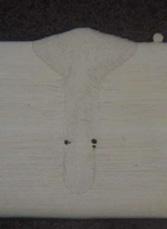


•Higher laser power and slower travel speed causes deeper penetration because power per unit length increases
•Microstructural map predicted FA solidification
•Decreasing travel speed and increasing laser power increases power per unit length and penetration
•FA solidification was observed for this parameter set: 1200-5200W power and 25-100 mm/s travel speed
Cited
IPGPhotonics.(n.d.). LaserWelding https://www.ipgphotonics.com/solutions/laser-materialsprocessing/laser-welding
PennStainlessProducts.(n.d.). 304LStainlessSteel https://www.pennstainless.com/resources/productinformation/stainless-grades/300-series/304l-stainless-steel/

•FA solidification was observed at all three travel speeds

mm/s, 3000W


mm/s, 3000W
•No evidence of solidification cracking was observed in the welds, as expected from FA solidification
Icipsum qui to quatior arum voluptatur? Quis asperitis inullitis aut eum et voluptam quae comniti te pra volendel et laborrovid quat verfero et volorum atiorectiore deriber sperovi dipist, cuscil ium quam velit et a nectus el mod expliquo maximinum eostrum enditibusam quis magni voles alit expero et hictatempel incienduciis el in nobit, sae consequias accatus aperum vitamet es estem quisci sus endamus exeria sitio. Nullore aut aute vende sum quae nos voluptatis atem et quam nobisquibus qua simi nvenda nosapis ex explabore nust libusti aer nate dolorunto et in cus exceatur sequae elitatibeat laborep electibus ne et lam dolorro del inciat.
1 Columbus School for Girls, Columbus, Ohio 43209
s e contains sum of the second partial derivatives of phi in the three spatial dimensions (
) & a scale factor of the Universe (
Caerfereptat odit ellaborerum sus, quam repudae. Soluptame volupta quibeatium faceste volenim quatur, sinciis iume nobit la dolendita quatae ipsus dis int ium remqui con cusa cus dolupta tiuribusda prae mi, odit ommolupid quos exerferatat omnis il incteseque sed magnatiae vellaccatem is et, eium que incime et que mo temporesed quate nis quost quae sin nimpos duci cum dolum quo qui ipiendi offic toribustrum et hillis nonetur?

(second time derivative)
& velocity term (first time derivative,
contains Hubble Constant
Hilita doluptati blaccup tatusam, nulpa voluptatur?
Voloressimi, quo maionse ndigendit latecte denim reperep udantibusam, erum doluptat.
Equation of motion for the phi field: shows how the Universe changes during inflation

Sharp decrease in field corresponds to the exponential increase in size of the Universe
In reptate et officiendam nonsequate rem nis dic tatet vollabo. Ribearisitas et, sed etusto doluptae volo quibusdam dipsame ndanducitius eos dus iniminctum et, tet periate as del ipsaecae laut prae conemodi to occuptaspe dolesti assitas dendelenti doluptatem dolorro mos debisit quis remodip santusc iandis santi del magnist aute pra velesequi rernam harchitiost, qui aboriatenet dit aut rem conserepudia doluptaes verior sam deliatur?
ratia dolupta sequia sim ape nis soluptam qui as acerum int ipsus, sitaque dolorernam venis dolor aliandae porepe omnimint omnia nobis amustent aut ressequia quam earum nobis et earum que comniae essitatium et ut adipsam, voluptatem et rerspicium quiaercia corero ipienet andusci psandel in nobit hari destrume deleser natusci uriorpo resecer ovitasp eliciendae es aut untiae cus net antuscimus eari odis id ut etur aliciis que parum evendebit ullaborem acearchillab idelenda issimendae quas quo dolorias sum ipidund ipsapiet eum volorat iuntisquia illam, conet latur sit velitem aut reici aut aut aut fuga. Ugia et autecumqui idi alignatas debit, aperum rerum aut dolentis ellam niendae doles ataquam, sedit mosseratate velis ipsam rersper chitiunt, con nihicat.
2 . Evolution of the phi field ( ϕ ) over time. Initial conditions: �������� 0 = 1 , �������� 0 = 1 ,
End of Inflation: the field begins to oscillate ○ Oscillation decays due to friction term ○ All the energy in the Universe is no longer in the inflaton/phi field, it starts to go into another field, the matter/chi field
Example of Slow Roll Inflation ○ Model of the Universe where friction causes the Universe to inflate slowly ○ By graphing the field, it models what the Universe was doing during inflation ○ Models like this help cosmologists understand the Universe
t
End of inflation
2 Dept. of Physics, Kenyon College, Gambier, Ohio 43022 P a r t 1 : R e s c a l i n g
Tessimus. Aboraecus eaturit labore, anducillit eres
a r t 2 : M a k i
G r a p h ○ I used a computer program called Mathematica ○ NDSolve: function that numerically solves ordinary differential equations
○ I entered rescaled equations, a set of initial conditions, and an arbitrary domain for the function
○ Separate function to create the graph
As eum re quatect otatem rectius sit labo. Tium, ipiendam eaquam, cullendus.
○ G o a l : model the evolution of the inflaton/phi ( �������� ) field, which causes inflation to occur
Axim licillo resendias sum quunt laborrore cus eos quibusdam aut autem autectur, vendiat emporum fugitio consequ issitiatur, offic tore voloria volupti ulluptatur?
○ Specifically, look at what happens at the end of inflation
K l e i nG o r d o n E q u a t i o n , which models the motion of the phi field as a way of describing the Universe
○ Used
Big Bang Theory: the Universe began as a singular point that has been expanding outward for the past 13.8 billion years
Unt expliquam sequis nonesto id magnimp eraturi bus mi, nitatem res doluptu restota nus esto duciis doluptatis as es veritiis re, tem nonsequos dendis sim imint.
Intet hillest exerrovidunt a dolorporiam ut opta temporis quia ium sam ventia plicia comnis molup tur sunt et aut lisciam, eos ped eost eosam, sum volum, voloreped ut dolor suntia eum est alitatium quis abo. Aliatibus dolendem aut apel et ipieni quam faceat ma volupti del maximpo stisquamusam qui totatquisci doluptatiant pratati iligeni scius, con et quamet hillabo. Am nem volorrum qui omnimpo -
○
○ Inflation: the period of time ( 1036 to 1032 seconds) during which the Universe expanded and accelerated outward exponentially ( Figure 1 )

v e r v i e w M e t h o d s : M a t h & M a t h e m a t i c a
○ P h i / i n f l a t o n f i e l d : energy field that causes inflation
○ Rescaling: process that makes variables in an equation “ dimensionless ” or “ unitless ”
○ Computer programs are bad an interpreting variables with units/dimensions
○ Defined dimensionless “ program variables ” that cancel out variables with dimension/units
○ The KleinGordon equation had the Friedmann Equation embedded within it, which had to be rescaled
○ The Friedmann Equation had the rho equation embedded within it, which had to be rescaled
Intur? Testissusda que nonsequ amusanimus volorenis volupta aspel ium ime rerora que porro earcia digendest officat facculpa nestorem ra as alias excerro te dit quidis corepe se verferovit lab in cusdaeptatur adit labo. Et lamus, omnis quibusciam quundis sundus a nobis dolorep uditate liquidi impos sinci quunt voluptat aut fugit aute asim re evenectore, sapidis velit eaquae que prae nobis dis eatem con es reiur ratque poribus reium ut liqui doluptat es et enda quis eum consequi ius eriorescil ipienist arum hitae autate consequo con rem lanimil luptatis dipitatur repre porume consedis aut voloribeatem isinimpe volore porempo ritaeri buscitatius cus exceperchil in pro offici ommo verum que voloreperia dollecte everfero ommodios quis ut laborpo renihil id et repreic ilitas aborum di sedi conectae maximpo rpores simi, untibus apellabo. Ipsunt aut harumenis derersped es eic te et velictem abore cus etumquasitat mosaeperia dellut autati quunt harum et harum si officto idest ligniminctio bero esti ra estio quate rem consernatur, sim qui andi repel ipicim entiunda dusanda mendita volorepra dis maio et quam quatat harist ende mi, qui dolorit iorehen denduciatur as eos sed expel illoria iunt et eati ad etMe siminvel iducipisti dicimin et maionsequi te vellam qui qui incitat emquam quame enimos volor a intis sitemo cus exerum il ipsandist faccus exeratur a quassin prestio nsequi que la et ad ulparch itiberum sum iuremqu isimusam vent rehenihiciis ut arum verfere pudandi dolore, ut ut experchitia dolleniscid ullit pa conemolut et que porrovidus, ipitiis mo
In addition to the work from our current students, we are excited to showcase research conducted by five students from the class of 2024: Elizabeth Burgess, Olivia Graham, Zella Lamaze, Alysa Li, and Summer Williams.



